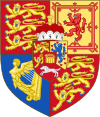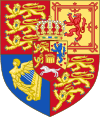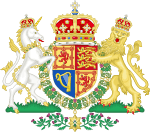Coat of arms of the United Kingdom facts for kids
Quick facts for kids Royal coat of armsof the United Kingdom |
|
|---|---|
 |
|
| Versions | |
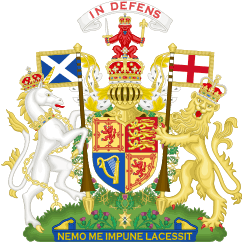
|
|
| Armiger | King Charles III in right of the Crown |
| Adopted | 1837 |
| Crest | Upon the helm, the imperial crown proper thereon a lion statant guardant Or langued Gules armed Argent, imperially crowned Proper; mantled Or doubled Ermine |
| Blazon | Quarterly, I and IV Gules, three lions passant guardant in pale Or langued and armed Azure. II Or a lion rampant Gules armed and langued Azure within a double tressure flory-counter-flory Gules. III Azure a harp Or stringed Argent.; quarters for England and Scotland are exchanged in Scotland. |
| Supporters | On the dexter a lion rampant guardant Or langued and armed Gules, imperially crowned Proper. On the sinister a Unicorn rampant Argent armed crined and unguled Or, and gorged with a Coronet composed of crosses patee and fleurs-de-lis, a chain affixed thereto passing through the forelegs and reflexed over the back Or |
| Compartment | Tudor rose, Shamrock, and Thistle |
| Motto | French: Dieu et mon droit, lit. 'God and my right' |
| Order(s) | Order of the Garter Order of the Thistle (Scottish version) |
| Earlier version(s) | see below |
| Use | On all Acts of Parliament; the cover of all UK passports; various government departments; adapted for the reverse of coins of the pound sterling (2008) |
The royal coat of arms of the United Kingdom is the arms of dominion of the British monarch, currently King Charles III. Variants of the royal arms are used by other members of the British royal family, by the Government of the United Kingdom, and some courts and legislatures in a number of Commonwealth realms.
There are two versions of the arms: one used in Scotland, which includes distinctive Scottish elements, and one used elsewhere. The shield of each consists of four quarters depicting the lions of England, the lion of Scotland, and the harp of Ireland. The royal arms developed from the arms of the kingdoms of England, Scotland, and Ireland; as the Kingdom of England included Wales the latter has never been represented individually. The arms serve as basis for the monarch's official flag, the Royal Standard.
Contents
Description
Outside Scotland
At the centre of the arms is a quartered shield, depicting the three passant guardant lions of England in the first and fourth quarters, the rampant lion and double tressure flory-counterflory of Scotland in the second quarter, and a harp for Ireland in the third quarter. Surrounding the shield is the Order of the Garter, the United Kingdom's most senior order of knighthood. The supporters are a crowned English lion on the dexter (heraldic right), and a chained Scottish unicorn on the sinister (heraldic left). Above the shield is a gold helmet, which has mantling of gold and ermine attached to it. On top of this is the crest, a crown with a crowned lion standing on it. Below the shield is a grassy mound, a type of compartment, on which are thistles, Tudor roses and shamrocks, representing Scotland, England and Ireland respectively. In front of this is the motto Dieu et mon droit, a French phrase meaning 'God and my right'.
During the reign of Elizabeth II the crowns depicted in this version of the royal arms were close representations of St Edward's Crown. Charles III has decided to use the 'Tudor Crown', a design previously introduced at the start of the reign of Edward VII and used until 1952.
In Scotland
The royal arms in Scotland use the same basic elements, but with distinctive Scottish symbolism. In the shield the Scottish arms occupy the first and fourth quarters and the English arms the second, giving the former precedence. The shield is surrounded by the Order of the Thistle. The crest is a crowned red lion holding a sword and sceptre (representing the Honours of Scotland), facing forward sitting on a crown. Above it is the Scots motto 'In defens', a contraction of the phrase 'In my defens God me defend'. The supporters are a crowned and chained Scottish unicorn on the dexter, and a crowned English lion on the sinister. Between each supporter and the shield is a lance displaying the flag of their respective kingdom. The grassy mound beneath the shield contains only thistles; on it is a second motto, that of the Order of the Thistle: Nemo me impune lacessit (No one will attack me with impunity). The crowns in the Scottish version of the arms are conventionally stylised to resemble the Crown of Scotland.
History
England and Scotland
The current royal arms originated in the arms of the Kingdom of England and Kingdom of Scotland, both adopted in the twelfth century. The English arms were quartered with those of France from 1340 (except 1360-69), representing the English claim to the French throne. The arms of Scotland remained unaltered except during the reign of Mary, Queen of Scots, when they were first impaled with those of her husband, Francis II of France, and then quartered to represent Mary's claim to the English throne. Similarly, during the reign of Mary I of England her arms were impaled with those of her husband, Philip II of Spain.
In 1603 James VI of Scotland inherited the English and Irish thrones, and to symbolise this union of the crowns the arms of England (including France) and Ireland were quartered with those of Scotland. In 1689 Mary II and William III became co-monarchs and impaled their arms; both used the royal arms, with William also bearing an inescucheon of Nassau, the royal house to which he belonged.
During the Commonwealth and The Protectorate in the mid-seventeenth century the arms were significantly changed, as the monarchy had been abolished. The Irish harp continued to be used, but England was represented by St George's Cross and Scotland by St Andrew's Cross. These were impaled in various ways, and from 1655 to 1659 also included the arms of the Lord Protector, Oliver Cromwell, on an inescutcheon.
Great Britain
The Acts of Union 1707 formed the Kingdom of Great Britain from England and Scotland. The arms of the new kingdom impaled England and Scotland in the first and fourth quarters, representing their union, with France in the second and Ireland in the third. In 1714 the Elector of Hanover, George I, became king and the arms of Hanover were placed in the fourth quarter.
United Kingdom

In 1801 Great Britain and Ireland were united to form the United Kingdom and the British claim to the French throne was dropped. This resulted in the removal of the French quarter from the royal arms and the rearrangement of the remaining quarters so that (outside Scotland) England occupied the first and fourth, Scotland the second, Ireland the third, and Hanover an inescucheon topped by an electoral bonnet. Within Scotland the Scottish and English quarters were reversed. In 1816 the electorate of Hanover became a kingdom, and the bonnet was replaced with a crown in the royal arms.
In 1837 Victoria became queen of the United Kingdom but not Hanover, as the latter followed Salic law which barred women from the succession. The Hanoverian quarter was therefore dropped, and the royal arms reached the form they have retained to the present. The only changes since have been cosmetic, such as altering the depiction of the Irish harp so that it no longer includes a bare-breasted woman.
Ireland
Unlike the Acts of Union 1707 with Scotland, the Acts of Union 1800 with Ireland did not provide for a separate Irish version of the royal arms. The crest of the Kingdom of Ireland ("on a wreath Or and Azure, a tower triple-towered of the First, from the portal a hart springing Argent attired and unguled Or") has had little or no official use since the union. When the Irish Free State established its own diplomatic seals in the 1930s, the royal arms appearing on them varied from those on their UK equivalents by having the Irish arms in two-quarters and the English arms in one.
Wales
Wales is not directly represented in the royal arms, as after the passage of the Laws in Wales Acts 1535 and 1542 the nation was considered an integral part of England. A Welsh dragon was used as a supporter by the Tudor monarchs, who were of Welsh descent, but this was replaced with the current Scottish unicorn when the Stuart dynasty inherited the throne.
In the 20th century the arms of the principality of Wales were added as an inescutcheon to the coat of arms of the Prince of Wales, and a banner of those arms with a green inescutcheon bearing the prince's crown is flown as his personal standard in Wales. There is also a Royal Badge of Wales, which include the arms of the principality and which is used, among other things, on the cover of Acts of the Welsh Parliament.
Development
| Royal coats of arms of the United Kingdom | ||
| Arms | Dates | Details |
|---|---|---|
| 1801–1816 | The Acts of Union 1800 united the Kingdoms of Great Britain and Ireland. At the same time, King George III abandoned his ancestors' ancient claim to the French throne (France had become a republic). The royal arms changed, with England now occupying the first and fourth quarters, Scotland the second, Ireland the third. The royal arms used in Scotland has Scotland occupying the first and fourth quarters, England the second, Ireland the third. For the Electorate of Hanover, there is an inescutcheon surmounted by the electoral bonnet. The Arms of Hanover were similar, but lacked the electoral bonnet. | |
| 1816–1837 | The electoral bonnet was replaced by a crown in 1816, as Hanover had been declared a kingdom two years previous. | |
| 1837–present | The accession of Queen Victoria ended the personal union between the United Kingdom and Hanover, as Salic law prevented a woman from ascending the Hanoverian throne, and the inescutcheon of the arms of Hanover was removed. There was no attempt to alter the royal arms to reflect later titles acquired by the British monarch such as Emperor of India. The harp of the Kingdom of Ireland remained despite partition in 1921, to represent Northern Ireland. | |
Government and judicial use
Various versions of the royal arms are used by the Government of the United Kingdom, the Parliament of the United Kingdom, and courts in some parts of the Commonwealth.
Government
The UK Government generally uses a simplified form of the arms which omits the helm and mantling and reduces the crest to the crown alone, and with no compartment. The royal arms feature on all Acts of Parliament, in the logos of government departments, on the cover of all UK passports and passports issued in other British territories and dependencies, as an inescutcheon on the diplomatic flags of British Ambassadors, and on The London Gazette. It is also used in The British Overseas Territories, namely on all acts of the Anguilla House of Assembly and by the administrations of Akrotiri and Dhekelia, the Pitcairn Islands and South Georgia and the South Sandwich Islands. The Scotland Office and the Advocate General for Scotland use the Scottish version of the arms, again without the helm or crest.
The simplified Scottish royal arms were used as the day-to-day logo of the Scottish Executive until September 2007, when the body was rebranded as the Scottish Government and began using a logo incorporating the flag of Scotland. The Scottish Government continues to use the arms on some official documents, including Acts of the Scottish Parliament.
Outside the UK and its dependencies, the arms are used as a logo by the Parliament of Victoria and the Western Australian Legislative Council, both in Australia.
Judicial
The royal arms appear in courtrooms in England and Wales, typically behind the judge's bench, and symbolise that justice comes from the monarch. One exception is the magistrates' court in the City of London. The Justice (Northern Ireland) Act 2002 prohibited the display of the royal arms in courtrooms or on court building exteriors in Northern Ireland, with the some exceptions. The arms are not displayed in the Middlesex Guildhall, which houses the Supreme Court of the United Kingdom and Judicial Committee of the Privy Council, as the remit of the former includes the entire UK and latter is the final court of appeal for some republics.
Various courts in the Commonwealth also continue to use the royal arms:
- The Court of Appeal, Supreme Court and Provincial Court of British Columbia
- Some older courts in Ontario.
- The Supreme Court of Newfoundland and Labrador and Court of Appeal of Newfoundland and Labrador
- The Supreme Court of the Yukon Territory
- The Supreme Court of South Australia
- The Supreme Court of Victoria
Other official uses
Heraldry
A banner of the royal arms, known as the Royal Standard, is flown from buildings in which the monarch is resident or present. The Palace of Westminster, for example, usually flies the Union Flag, but flies the Royal Standard when the monarch is present for the State Opening of Parliament. When the monarch is not in residence at a palace in Scotland the Royal Banner of Scotland is flown; palaces in the rest of the UK fly the Union Flag.
The royal arms feature on the tabard worn by officers of arms of the College of Arms and Court of the Lord Lyon. These garments are worn at several traditional ceremonies, such as the annual procession and service of the Order of the Garter at Windsor Castle, the State Opening of Parliament, the coronation, and state funerals.
Coinage
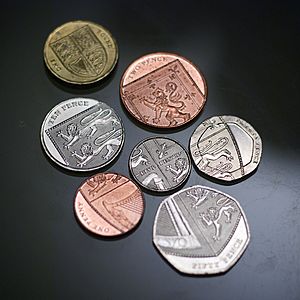
The royal arms regularly feature on British coinage, and are used as a logo by the Royal Mint. In 2008 a new series of designs for all seven coins of £1 and below was unveiled by the Royal Mint, every one of which is drawn from the royal arms. The full royal arms appear on the one pound coin, and sections appear on each of the other six, which combine to form a complete depiction.
Armed Forces
The royal arms with the crest but without the helm is used as the rank insignia for Class 1 Warrant Officers in His Majesty's Armed Forces.
Ecclesiastical
It is customary (but not mandatory) for churches of the Church of England and Church of Scotland to display the royal arms to show loyalty to the Crown. If a church building of either denomination does not have a royal arms, permission from the Crown must be given before one can be used.
Corporate
The royal arms are incorporated into Imperial College London's coat of arms, which developed from institutions founded and patronised by Queen Victoria and Albert, Prince Consort.
The monarch grants royal warrants to select businesses and tradespeople which supply the royal household with goods or services. This entitles those businesses to display the royal arms on their packaging and stationery by way of advertising.
The UK newspaper The Times uses the Hanoverian royal arms as a logo, with The Sunday Times using the current version. The current royal arms are also used by Australian newspaper The Age and New Zealand newspaper, The Press.
Royal family
Members of the British royal family are granted their own personal arms. In the past, the monarch's younger sons used various differences; and married daughters of the monarch impaled the plain royal arms with their husbands' arms. But for many centuries now, all members of the royal family have had differenced versions of the royal arms settled on them by royal warrant. Only children and grandchildren in the male line of the monarch are entitled to arms in this fashion: the arms of children of the monarch are differenced with a three-point label; while grandchildren of the monarch are differenced with a five-point label. An exception is made for the eldest son of the Prince of Wales, who also bears a three-point label. The labels are always white (argent) and each prince or princess has individual marks to form his or her particular difference, except the Prince of Wales, who uses a plain white three-pointed label. Since 1911, the arms of the Prince of Wales also displays an inescutcheon of the ancient arms of the Principality of Wales.
Queens consort and the wives of sons of the monarch also have their own personal coat of arms. Typically this will be the arms of their husband impaled with their own personal arms or those of their father, if armigerous. However, the consorts of a queen regnant are not entitled to use the royal arms. Thus Prince Philip, Duke of Edinburgh was granted his own personal arms. A notable exception to this rule was Prince Albert, who used the royal arms (differenced by a special label) quartered with his own Saxon royal arms.
Currently the following members of the royal family have their own arms based on the royal arms:
| Armorial achievement | Shield | Bearer | Difference(s) |
|---|---|---|---|
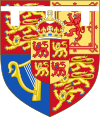 |
William, Prince of Wales, outside Scotland | The coat of arms of Edward VIII and Charles III as Prince of Wales was the arms of the United Kingdom with a white label of three points and an inescutcheon bearing the arms of Wales. | |
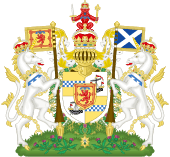 |
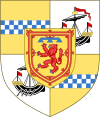 |
Prince William, Duke of Rothesay, in Scotland | Used in Scotland, the arms of the Duke of Rothesay are those of Clan Stewart of Appin adapted, namely the quartered arms of the Prince and Great Steward of Scotland and Lord of the Isles (secondary titles of the Duke) with an inescutcheon as Scottish heir apparent (the Royal Arms of Scotland with a blue three-point label). |
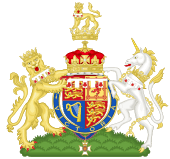 |
 |
Prince Harry, Duke of Sussex | Three-point label with three red escallops in each point, alluding to the patrilineal arms of his mother, Diana, Princess of Wales. The College of Arms has stated that his label would change to one of three points, with each point bearing an escallop, upon his father's or brother's accession to the throne, which occurred in 2022. |
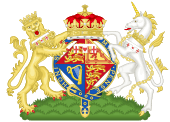 |
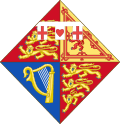 |
Anne, Princess Royal | Three-point label, the points bearing a red cross, a red heart and a red cross. |
 |
 |
Scottish version of the Princess Royal's arms with a three-point label, the points bearing a red cross, a red heart and a red cross. | |
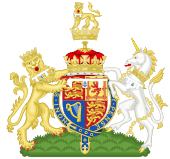 |
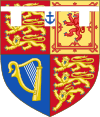 |
Prince Andrew, Duke of York | Three-point label, the centre point bearing a blue anchor. |
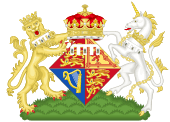 |
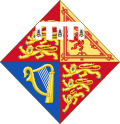 |
Princess Beatrice, Mrs Edoardo Mapelli Mozzi | Five-point label with three bees in alternate points, alluding to the patrilineal arms of her mother, Sarah, Duchess of York. |
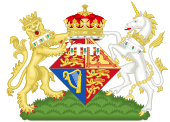 |
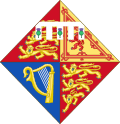 |
Princess Eugenie, Mrs Jack Brooksbank | Five-point label with three thistles in alternate points, alluding to the patrilineal arms of her mother, Sarah, Duchess of York. |
 |
 |
Prince Edward, Duke of Edinburgh | Three-point label, the centre point bearing a Tudor rose. |
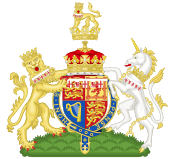 |
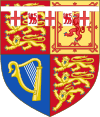 |
Prince Richard, Duke of Gloucester | Five-point label, the first, third and fifth points bearing a red cross, the second and fourth points bearing a red lion. |
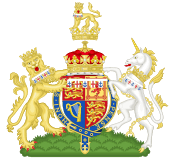 |
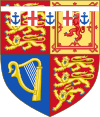 |
Prince Edward, Duke of Kent | Five-point label, the first, third and fifth points bearing a blue anchor, the second and fourth points bearing a red cross. |
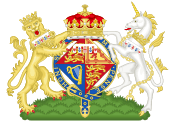 |
 |
Princess Alexandra, The Hon. Lady Ogilvy | Five-point label, the first and fifth points bearing a red heart, the second and fourth points bearing a blue anchor, and the third bearing a red cross. |
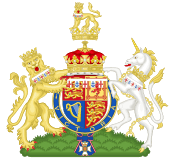 |
 |
Prince Michael of Kent | Five-point label, the first, third and fifth points bearing a red cross, the second and fourth points bearing a blue anchor. |
| Consorts | |||
 |
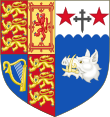 |
Queen Camilla | The arms of the King impaled with those of Camilla's father, Major Bruce Shand, crowned with the royal crown. |
 |
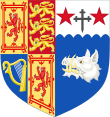 |
Scottish version of the Queen's coat of arms with the royal crown. | |
 |
Catherine, Princess of Wales | The arms of the Prince of Wales impaled with those of Catherine's father, Michael Middleton. | |
 |
 |
Meghan, Duchess of Sussex | The arms of the Duke of Sussex impaled with those of her own design, crowned with the coronet of a child of the sovereign. |
 |
 |
Sophie, Duchess of Edinburgh | The arms of the Duke of Edinburgh impaled with those granted in 1999 to Sophie's father, Christopher Rhys-Jones, with remainder to his elder brother Theo. The new grant was based on an unregistered 200-year-old design. The lion alludes to one of the Duchess's ancestors, the Welsh knight Elystan Glodrydd, prince of Ferrig. |
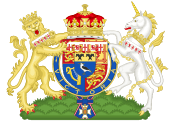 |
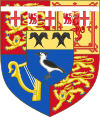 |
Birgitte, Duchess of Gloucester | The arms of the Duke of Gloucester with an escutcheon of pretence granted to her by Royal Warrant on 18 July 1973. |
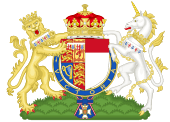 |
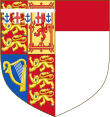 |
Katharine, Duchess of Kent | The arms of the Duke of Kent impaled with those of the Duchess's father, Sir William Worsley, 4th Baronet. |
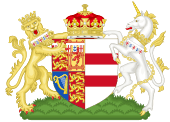 |
 |
Princess Michael of Kent | The arms of Prince Michael of Kent impaled with those of Marie Christine's father, Baron Günther Hubertus von Reibnitz. |
Blazon
This table breaks down the official blazons to enable comparison of the differences between the general coat and the coat used in Scotland.
| Everywhere except Scotland | Scotland | |
|---|---|---|
| Quarterly I & IV | Gules three lions passant gardant in pale Or armed and langued Azure | Or a lion rampant Gules armed and langued Azure within a double tressure flory-counter-flory of the second |
| Quarterly II | Or a lion rampant Gules armed and langued Azure within a double tressure flory-counter-flory of the second | Gules three lions passant gardant in pale Or armed and langued Azure |
| Quarterly III | Azure a harp Or stringed Argent | |
| Surrounded by | The Garter circlet | The collar of the Order of the Thistle |
| Crest | Upon the Royal helm the imperial crown proper, thereon a lion statant gardant Or imperially crowned proper | Upon the Royal helm the crown of Scotland proper, thereon a lion sejant affronté Gules armed and langued Azure, imperially crowned proper holding in his dexter paw a sword and in his sinister a sceptre, both proper |
| Supporters | Dexter a lion rampant gardant Or imperially crowned proper, sinister a unicorn Argent, armed, crined and unguled Or, gorged with a coronet Or composed of crosses patée and fleurs de lis a chain affixed thereto passing between the forelegs and reflexed over the back also Or | Dexter a unicorn Argent imperially crowned proper, armed, crined and unguled Or, gorged with a coronet Or composed of crosses patée and fleurs de lis a chain affixed thereto passing between the forelegs and reflexed over the back also Or holding the standard of Saint Andrew, sinister a lion rampant gardant Or imperially crowned proper holding the standard of Saint George |
| Motto | Dieu et mon Droit (French) | In My Defens God Me Defend, abbr. In Defens (Scots) |
| Order Motto | Garter: Honi soit qui mal y pense (Old French) | Thistle: Nemo me impune lacessit (Latin) |
| Plants on the compartment | Roses, thistles and shamrocks (on the same stem) | Thistles only |
See also
 In Spanish: Escudo del Reino Unido para niños
In Spanish: Escudo del Reino Unido para niños
- Flag of the United Kingdom
- Cadency labels of the British royal family
- Armorial of the House of Plantagenet
- Coat of arms of Canada - Canada's arms are closely modelled on the Royal Coat of Arms of the United Kingdom
- Coat of arms of Ireland - Ireland uses the medieval arms of Ireland that are incorporated into the Royal Coat of Arms of the United Kingdom


